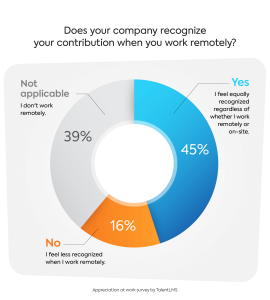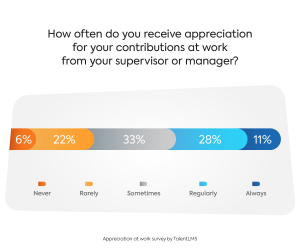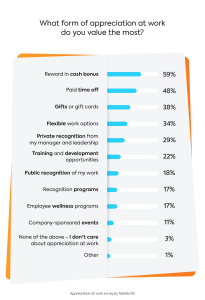In the latest TalentLMS survey, we increased the respect of employees in American companies. We examined how employees view appreciation practices. And their favorite ways to receive recognition. Moreover, we explored the potential of artificial intelligence to bridge the employee recognition gap. The research also explored generational differences surrounding appreciation. And investigated whether remote employees and on-site employees are equally recognized.
The results? At the highest level, we see mixed feelings about recognition in the workplace. But what does it look like in detail?
Let’s see what else the data revealed.
Does workplace affect employee gratitude? Almost half say no
Forty-five percent of employees feel recognized, whether they work remotely or on-site. Only a minority, 16%, believe that they receive less recognition when they work outside the company.

This tells us two things.
Yes, most companies have good recognition practices in different work environments and arrangements. But they still need to work on bridging the gap between remote deployment and on-site deployment. Sixteen percent may seem like a small proportion of respondents. But distance affects the visibility of some employees’ efforts and contributions. And, in order to ensure equality for all, it calls for strategies aimed at that minority.
Generation gap: Younger employees claim to feel less valued than their older colleagues
Delving deeper into the data, a divide in views between age groups emerges.
Seventy percent of employees over the age of 54 say they feel valued at work. This is in stark contrast to younger employees. Only 49% of people aged 24 and under feel recognized. And the figure continues to fall: Thirty percent Generation Z workers do not feel valued at work.
The uneven distribution of respondents by age category affects these findings. This means that they offer a broad view rather than precise comparisons. However, they clearly highlight the generational gap in recognition in the workplace. AND Gallup surveys supports this. According to their data, engagement levels for Gen Z are low. Especially? More than half of the youngest employees are ambivalent or disengaged at work.
Reducing the recognition gap: Most employees feel recognized, but not enough
Let’s start with the good news. Less than a quarter of employees, 23% of them, feel undervalued at work. While a healthy 62% feel valued.
But is the feeling valued enough?
Some of the findings on employee appreciation were contradictory. To deconstruct the nuances, we looked at perception and frequency of appreciation. Here’s what we found.
Twenty-eight percent of workers rarely or never they receive praise for their work from the manager. And 33% are recognized only sometimes.
What does it mean? A total of 61% of the workforce does not receive regular praise from their superiors. Or they don’t feel appreciated.
Additional research moving on with this. More than half (59%) of employees believe that they have never had a boss who appreciated them, it says.
Our data revealed other areas that need refinement. Forty-seven percent of employees feel valued every day. But a a significant 36% believe that their work is recognized only through formal evaluation.
In short, managers have a lot of room to improve their appreciation skills. They should offer praise more regularly, formally and informally. And they must work harder to ensure that praise (when given) is effectively delivered and accurately received.
What form of gratitude do employees value most?
Employees in various sectors have long preferred cash bonuses over other rewards. The results of our survey confirm that this is still the case for most employees. But not all.
As shown in the graph below, of all employees surveyed, 59% prefer cash bonuses over PTO. This special type of reward is followed by paid time off (PTO), then gifts or gift cards.

But when we break it down by generation, we begin to see the divide.
Cash bonuses are the top voted employee rewards across generations, but the youngest workers’ top choice is PTO
Younger employees still opt for tangible rewards over recognition. But given the choice, Gen Z employees chose PTO over cash. The youngest working generation, up to 24 years old, marked PTO as the most valuable form of gratitude.
This choice suggests a deeper longing for work-life balance rather than monetary incentives. It also indicates a change in mindset. Younger generations view PTO not as a perk, but as the most desirable form of gratitude.
L&D and appreciation: Most feel valued through workplace learning, yet 3 in 10 seek recognition for skills development
Workplace learning and appreciation are key ingredients a a culture of growth and recognition. And they significantly affect employee satisfaction. This dynamic is highlighted by the results of our survey.
Most employees recognize the link between L&D and gratitude: Fifty four percent he said their company shows appreciation by investing in training and development opportunities. Half of respondents also prioritize their companies for recognizing when employees are upgrading their skills.
But there is a twist.
Thirty percent are not satisfied with the way their companies show appreciation when they improve their capabilities.
These findings indicate a need for two things. Companies should invest in the professional development of their employees. But they should also follow up by offering recognition of acquired skills and expertise.
Looking for a learning platform that will encourage knowledge sharing?
Train your employees with TalentLMS.
Easy to set up, easy to use, easy to customize.
AI-Powered Praise: More than a third of employees embrace AI
The role of artificial intelligence in employee recognition emerged as a divisive topic.
On the one hand, there is a slight preference for AI-powered recognition. Thirty six percent employees find it a pleasure to receive thanks and recognition from AI for their work contribution. And 41% think AI-driven programs could improve their company’s approach to employee recognition.
On the other hand, a slightly smaller percentage of employees are skeptical in both cases. Thirty-three percent do not appreciate praise from artificial intelligence. And 27% doubt that it will affect the strategic recognition of the workplace.

These views highlight the divisions in perceptions of the place of artificial intelligence in the human-centered world of recognition.
So what’s next?
Employees appreciate receiving recognition from their manager most. So logic suggests that the application of artificial intelligence should respect this. But we also learned that frequency of praise is a problem. This opens up a clear role for AI.
By using generative technology, managers can automate some elements of the recognition process. And strengthen your personal contributions with more regular contacts.
Building a Culture of Appreciation: Leadership Appreciation, Milestone Celebrations, and Personalization
Fifty-five percent of the workforce feels that their leaders show genuine respect for employees. An even higher proportion, 56%, agree that their company celebrates work anniversaries and milestones. And it showcases a culture that values and celebrates employees’ special moments.
This generally indicates a positive recognition culture. Supported by a personalized approach to recognition. Which is reflected in the second finding. Fifty-two percent of employees said that at their company, employee appreciation is personalized.
Bottom line: Solving challenges under the radar
The power of gratitude in the workplace goes beyond mere recognition. It is a simple but profound force that fosters a positive culture. How does it look? Increased job satisfaction, loyalty and sense of belonging. Strong, collaborative teams. Ecosystems that thrive. And the basis of respect and support.
In short, it pushes people and organizations to succeed.
Achieving all this requires a strategic approach. This is where this survey comes into play. Our data highlights a number of challenges that go unnoticed and should not be ignored. Yes, most employees feel valued by management and, in general, recognized by their organization. But the appreciation gap remains – especially among younger employees.
The data also sheds light on cracks in middle management’s approach to appreciation. And it reveals room for improvement in frequency amplification. Finally, it reveals the need for more diverse and frequent recognition strategies. With a commitment to exploring the role of artificial intelligence in strategically increasing appreciation.
So. Lots to do. Lots to improve. But also a lot to gain.